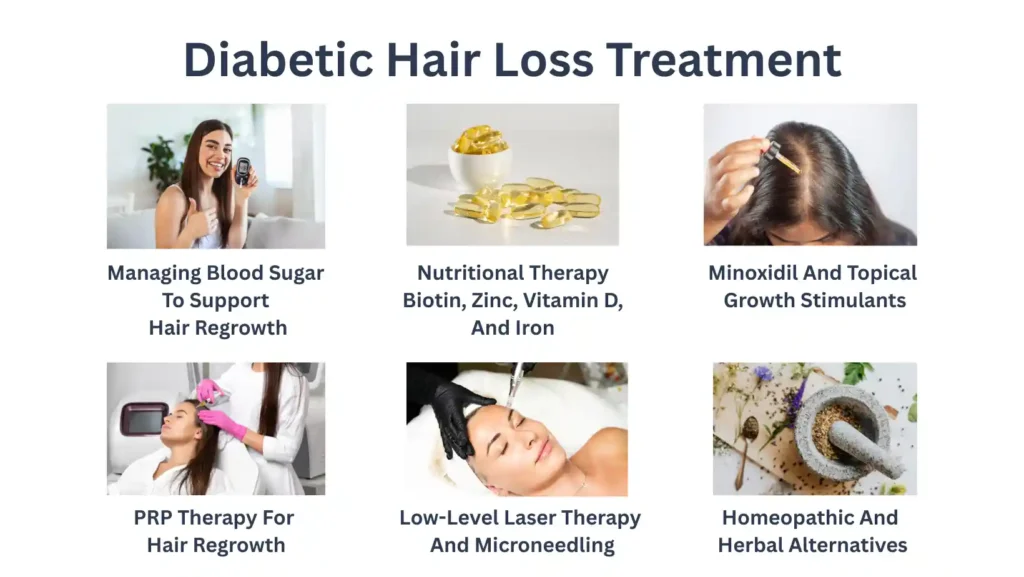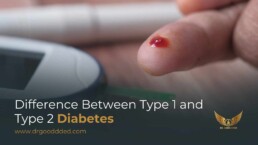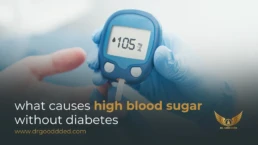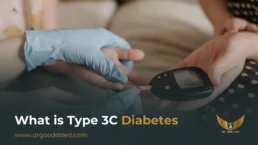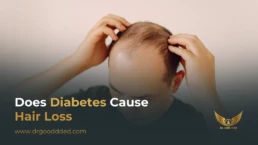Diabetes can cause hair loss. That is the clear answer. High sugar can hurt tiny blood vessels, strain hormones, and slow new growth. When these three issues stack up, shedding rises, and hair gets thin.
Table of Contents
ToggleFixing sugar, checking nutrients, and using proven scalp treatments can slow or reverse the trend. That is why doctors take hair complaints seriously in people with diabetes. Your hair is part of your health story.
How Diabetes Affects Hair Growth
Hair grows in cycles. The growth phase needs oxygen, nutrients, and steady hormones. Sugar swings make this system unstable. That is one core way diabetes can cause hair loss. You may notice more strands on the pillow, slower regrowth, and a wider part. These signs often improve when sugar control improves.
How High Blood Sugar Damages The Scalp’s Microcirculation
Tiny vessels feed your follicles. High glucose can stiffen and narrow these vessels. Less blood reaches the root. Oxygen falls. Roots shrink. Over time, the hair shaft gets thin. This is a common diabetes hair loss. Good A1C and fewer spikes protect those vessels. That protects the follicle.
The Effect Of Insulin Resistance On Follicle Health
Insulin moves sugar into cells. When cells resist insulin, sugar and insulin both rise. Follicles feel that stress. Cell energy drops. Inflammation builds. More hairs shift into the rest phase too soon. Then shedding rises in clumps. This is another path by which diabetes can cause hair loss.
Hormonal Imbalance And Its Role In Hair Thinning
Insulin resistance can raise androgens. Androgens can shrink follicles if you are prone. Women may see a wider part and a thinner ponytail. Men may see faster temple loss. When hormones swing, the cycle breaks. That is a key reason diabetes can cause hair loss across ages and sexes.
The Connection Between Oxidative Stress And Follicle Miniaturization
High glucose creates more free radicals. These damage cell parts. Follicles are sensitive to that damage. The result is miniaturization, which means shafts grow back thinner. Antioxidant foods help, yet sugar control matters more. This chain explains how diabetes affects hair growth in daily life.
Type 1 Vs Type 2 Diabetes: How Hair Loss Differs
Hair loss patterns overlap in Type 1 vs Type 2 Diabetes, yet the drivers can differ. Type 1 often links with immune attacks. Type 2 centers on insulin resistance and long-term sugar load. Knowing which force is stronger helps you and your doctor pick the right plan.
Why Autoimmune Reactions In Type 1 Diabetes Cause Patchy Bald Spots
Type 1 can occur with alopecia areata. The immune system attacks the follicle by mistake. You may see round bald patches on the scalp, brows, or beard. The skin looks smooth. It can flare and then calm. Early care can bring regrowth. This is a distinct way diabetes can cause hair loss in Type 1.
How Insulin Resistance In Type 2 Diabetes Contributes To Chronic Thinning
Type 2 raises insulin and glucose for years. Blood vessels suffer. Hormones shift. Inflammation lingers. Thinning is slow and even. The crown looks see-through. The part widens. This steady pattern fits many cases in Type 1 vs Type 2 Diabetes comparisons and shows why diabetes can cause hair loss even without bald patches.
Differences In Regrowth Patterns Between Type 1 And Type 2 Diabetics
After an immune flare settles, Type 1 regrowth can start fast, then stall if another flare returns. In Type 2, growth tends to be slow and steady as glucose and insulin improve. You may first feel soft baby hairs along the hairline. Shaft thickness usually improves later. Patience is vital either way.
Can Type 2 Diabetes Hair Loss Be Reversed With Lifestyle Change?
Often yes. Weight loss reduces insulin resistance. Regular activity improves blood flow. A balanced carb plan cuts spikes. Together, these steps reduce several drivers at once. Many people see less shedding in three months. Density can improve over six to nine months. This shows how diabetes can cause hair loss, yet smart habits can shift the arc toward regrowth.
Common Symptoms Of Diabetic Hair Loss
You might miss the early signs. Watch for small clues and track them with monthly photos in the same light. Early action saves time and strands.
Gradual Thinning Of Scalp And Eyebrow Hair
Scalp thinning comes first. Brows can thin next. The change is even, not patchy. This is a common diabetes hair loss that builds over months. Address sugar control and nutrients early.
Increased Hair Shedding After Washing Or Brushing
Some shedding is normal. A clear jump points to a growth cycle shock. Sugar spikes, illness, and stress can push many hairs into rest at once. Shedding then rises two or three months later. This pattern explains how diabetes can cause hair loss without scalp pain or rash.
Slower Regrowth And Reduced Hair Density
Fewer new short hairs appear at the hairline. The ponytail feels smaller. The crown shows more skin in bright light. These signs often fade once the cycle resets.
Hair Feeling Finer, Weaker, Or “Thinner” Over Time
Shafts lose thickness. Styles fall flat. Heat tools leave more breakage. Miniaturization is in play. That process links back to sugar control and hormones. It is one more way diabetes can cause hair loss if left unchecked.
Diabetes Hair Loss Causes
Many paths can overlap. You may have several at once. A strong plan checks each one and fixes what is fixable.
Poor Blood Circulation To Hair Roots
Glycation makes vessels stiff. Plaque can build up. Microvessels narrow. Roots get less oxygen and fewer nutrients. Hair quality drops. This is a major diabetes hair loss and a clear reason to chase better A1C.
Hormonal Imbalances And Insulin Resistance
High insulin can raise androgens. Androgens shrink follicles in those who are sensitive. The result is slow thinning across the top. The sides may stay fuller. This also explains how diabetes affects hair growth, even when labs look close to normal.
Immune System Inflammation And Autoimmune Overlap
Type 1 links with alopecia areata and thyroid disease. Type 2 shows chronic low-grade inflammation. Both can shock the growth cycle. When inflammation calms, regrowth improves. That is why a full medical review matters.
Stress And Chronic Illness Effects
Poor sleep, pain, infection, or a big life event can trigger a shedding called telogen effluvium. The trigger comes first. The shed shows up months later. This time lag confuses many people. It still fits the story of how diabetes can cause hair loss during tough seasons.
Medication Side Effects Contributing To Thinning
A few drugs can raise the risk. Metformin can reduce B12 in some people over time. Low B12 can add to thinning. Never stop a drug on your own. Ask for labs and replace what is low. That keeps the benefits while protecting hair.
Diabetic Hair Loss Treatment
Treatment works best when it covers the root causes and the scalp. You build a base with glucose control and nutrients. Then you add topical or clinic therapies. This layered method is the heart of diabetic hair loss treatment.
Managing Blood Sugar To Support Hair Regrowth
Target steady days with fewer highs and lows. Spread carbs across meals. Pair carbs with protein and fiber. Take a ten-minute walk after eating. These steps can improve time in range. When sugar steadies, blood flow improves, and inflammation eases. That change alone can reduce shedding. It is also the reason diabetes can cause hair loss when control slips for months.
Nutritional Therapy: Biotin, Zinc, Vitamin D, And Iron
Hair is a protein. It also needs iron, zinc, and vitamin D to build and cycle. Low ferritin can stall growth. Low D can change the timing of the cycle. Low zinc can slow repair. Biotin helps only if you are low. Ask for tests before adding pills. Replace what is low to keep the plan safe and targeted. This is a simple yet vital part of diabetic hair loss treatment.
Minoxidil And Topical Growth Stimulants
Minoxidil can push resting follicles back into growth. Foam and liquid forms both work. Use as directed each day. A brief shed can start in weeks two to six. That is the reset. Keep going for at least six months before judging. Combine it with glucose control for better odds. This mix explains why diabetes can cause hair loss, yet you can still nudge the cycle toward thicker strands.
PRP Therapy For Hair Regrowth
Platelet-rich plasma uses your own platelets. A clinician injects small amounts into the scalp. Growth factors can boost follicle activity. Sessions often run monthly at first. Many people report thicker shafts and lower shed. Response varies and depends on the base work you do with sugar and nutrients.
Low-Level Laser Therapy And Microneedling
Laser caps and combs can increase scalp blood flow and cell activity when used on a set schedule. Microneedling creates tiny channels that may help topicals reach deeper. Both are helpers. They work best when paired with minoxidil and strong metabolic control. This combined plan forms a solid diabetic hair loss treatment path.
Homeopathic And Herbal Alternatives
Some people try rosemary oil, pumpkin seed oil, or saw palmetto. Evidence is modest. A few see improved hair counts or comfort. Always dilute essential oils in a carrier oil to avoid irritation. Use these as add-ons, not as the only step. Keep your doctor in the loop.
Natural And Home Remedies For Diabetes Hair Loss
You can support your scalp at home using gentle habits that protect follicles and improve comfort. These steps are not replacements for medical care, but they can help the scalp environment stay healthy. Many look for natural and home remedies for diabetes hair loss because they want simple daily actions that feel doable. These methods can be used alongside medications, diet changes, and clinic treatments.
Nutrients That Promote Follicle Recovery: Biotin, Zinc, And Vitamin D
Hair roots need fuel and building blocks. When your diet lacks these nutrients, follicles slow down.
Helpful foods include:
- Eggs and lean meat for protein and biotin
- Nuts and seeds for zinc
- Salmon and fortified dairy for vitamin D
If your blood tests show low levels, your doctor may recommend supplements. Correcting these can improve regrowth. These steps support your plan when diabetes affects hair growth and hair feels weaker.
Herbal And Ayurvedic Remedies For Scalp Blood Flow
Some people apply plant-based oils to soothe dryness and encourage circulation. These do not fix deep medical causes, but they can help the scalp feel healthier.
Examples include:
- Rosemary oil diluted in coconut or olive oil
- Bhringraj oil applied to the scalp
- Amla oil to soften hair strands
Massage the oil gently into the scalp. Leave it for one or two hours before washing. Many include these as part of natural and home remedies for diabetes hair loss while also managing blood sugar and nutrition.
Gentle Scalp Massages To Stimulate Circulation
Using your fingertips, rub the scalp in small circles. Five minutes each day helps. It increases blood flow and relaxes tight scalp muscles. This supports the follicles, especially when diabetes can cause hair loss by narrowing blood vessels.
Avoiding Chemical-Heavy Hair Products That Worsen Shedding
Hair roots already face stress from sugar swings. Using harsh dyes and high heat styling can increase breakage.
Try:
- Sulfate-free shampoo
- Low heat drying
- Fewer chemical treatments
A calm scalp allows other treatments to work better.
Diet And Lifestyle Changes For Healthier Hair
Your daily habits affect hair more than most people realize. When diabetes can cause hair loss, improving your lifestyle can support recovery from the inside.
Balancing Carbohydrates And Improving Insulin Sensitivity
Big sugar spikes strain your follicles. Spread carbohydrates evenly across meals. Pair carbs with protein and fiber to slow absorption.
One simple method: Eat your vegetables first, protein second, carbs last. This helps reduce spikes.
This routine also improves outcomes in both Type 1 vs Type 2 Diabetes hair loss cases.
Protein-Rich Diets To Support Keratin Production
Hair is made of keratin protein. If you do not eat enough protein, your hair may not grow strong.
Good sources include:
- Fish
- Chicken
- Beans
- Lentils
- Tofu
- Yogurt
This step helps when diabetes hair loss relates to slowed hair building.
Stress Management Techniques To Reduce Cortisol Spikes
Stress raises cortisol and blood sugar. Together, these can push many hairs into the resting phase.
Simple stress reduction habits:
- Slow deep breathing
- Short daily walks
- Keeping a stable sleep routine
Less stress means less shedding.
Hydration And Proper Sleep For Metabolic Balance
Drink water throughout the day. Sleep helps the body repair tissue and regulate hormones. If sleep is poor, shedding can increase. Fixing sleep supports both hair and blood sugar.
Preventing Hair Thinning In Diabetics
Stopping the problem early is easier than reversing it later. Prevention matters, especially when diabetes can cause hair loss slowly over time.
The Importance Of Early Glucose Control For Scalp Health
Good control protects blood vessels and reduces inflammation. It protects the growth cycle. Even small improvements help.
How Regular Exercise Improves Hair Regrowth
Movement increases blood flow to the scalp and improves insulin sensitivity. You do not need intense workouts. Even walking thirty minutes a day is enough to help.
Avoiding Smoking And Alcohol To Enhance Blood Flow
Smoking narrows blood vessels. Alcohol can raise blood sugar. Both can block recovery. Reducing or stopping them helps follicles receive more oxygen.
Why Consistent Medical Follow-Ups Prevent Chronic Hair Loss
Checkups help correct vitamin levels, medication dosing, and thyroid function. Small corrections can lead to large improvements in growth. This is often a key part of diabetic hair loss treatment success.
How To Diagnose Diabetes Related Hair Loss
When To See An Endocrinologist Or Dermatologist
See an endocrinologist if blood sugar is hard to control. See a dermatologist if you notice fast shedding or bald patches. Team care is often best when diabetes affects hair growth.
Blood Tests For A1C And Thyroid Disorders
Ask your doctor for:
- A1C
- Fasting glucose
- Ferritin (iron storage)
- B12
- Vitamin D
- Thyroid panel
These tests reveal hidden causes that add to thinning.
Scalp Examination And Hair Density Mapping
A dermatologist may use a handheld scope to check follicle size and hair density. This shows whether miniaturization is happening and guides treatment choices.
When To See A Doctor For Diabetes Related Hair Loss
Warning Signs Of Nutrient Or Hormonal Imbalance
If you feel tired, cold often, or notice brittle nails, you may have low iron or a thyroid imbalance. Correcting these can improve growth speed.
When Hair Loss Indicates Uncontrolled Diabetes
If shedding increases while thirst, hunger, or frequent urination also rise, your blood sugar may be too high. Fixing control often reduces shedding within months.
What To Ask Your Endocrinologist Or Trichologist
Good questions include:
- Should I test vitamin and iron levels
- Is my current A1C goal right for me
- Which topical or oral treatments fit my hair pattern
- Should I try minoxidil, PRP, or laser therapy
FAQ
Can diabetes cause permanent baldness?
diabetes can cause hair loss that becomes long lasting if blood flow and hormones stay unbalanced for years. Early treatment improves the chance of regrowth and prevents further thinning.
Does insulin therapy help with hair regrowth?
Insulin therapy can stabilize blood sugar. When sugar stays stable, inflammation and vessel damage slow, which can support hair regrowth and reduce shedding over time.
What nutrients are best for diabetic hair recovery?
Iron, vitamin D, B12, zinc, and protein are key for hair growth. Testing levels helps you know what your body needs so you avoid wasting money on supplements.
Can high blood sugar alone cause hair loss?
Yes. High sugar harms small blood vessels and increases oxidative stress, which can weaken hair roots and lead to shedding over time.
Does metformin contribute to hair thinning?
Metformin usually helps hair by improving sugar control, but it may lower B12 in some people. Low B12 can increase shedding. Testing and supplementing can prevent this issue.
How long does it take for hair to grow back after controlling diabetes?
You may notice reduced shedding in two to three months. Visible thickening may take six to nine months or longer because hair grows slowly and needs time to rebuild.
Is hair loss more common in women with Type 2 diabetes?
Yes. Women with insulin resistance may experience hormone shifts that affect the scalp, leading to gradual thinning along the part and crown over time.
What shampoo is best for diabetic scalp health?
Use a mild, low fragrance shampoo that cleans without drying the scalp. A calm and balanced scalp helps support regrowth and reduces breakage.

This article is medically reviewed by Dr. Chandril Chugh, Board-Certified Neurologist, providing expert insights and reliable health information.
Dr. Chandril Chugh is a U.S.-trained neurologist with over a decade of experience. Known for his compassionate care, he specializes in treating neurological conditions such as migraines, epilepsy, and Parkinson’s disease. Dr. Chugh is highly regarded for his patient-centered approach and dedication to providing personalized care.


